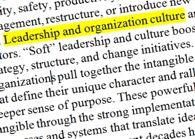Organizational culture development is a complex topic with many intertwined leadership components. Establishing a peak performance culture in what’s sometimes called a “green field” situation has different challenges than changing an established culture (sometimes called “brown field”).
In response to my July blog, RIM/Blackberry is at a Critical Leadership Crossroad, a subscriber sent me this e-mail focusing on that difference:
 “RIM may come through their struggles because their culture may still remain fresh and “open enough for real enquiry” and understanding. But many companies are older organizations and are simply staid and entrenched.
“RIM may come through their struggles because their culture may still remain fresh and “open enough for real enquiry” and understanding. But many companies are older organizations and are simply staid and entrenched.
I know you are a great advocate of personal growth in our leaders. How do you bring this about in organizations? Personal development (or self awareness being the more accurate description) does not come from reading a few books or attending the odd seminar. Much like attending a psychologist or counseling, it requires a genuine desire for change/growth and sustained effort, sometimes over many years. Most contemporary leaders would simply be too busy or challenged by it to want to engage in this sort of thing. How do you think we can tackle this dilemma?”
This reader put his finger on a key challenge of revitalizing an established “brown field culture.” It has to start with the understanding and motivation of the organization’s key leaders for deep and sustained change. Often that means a transformation. Rarely will incremental change or implementing current practices more efficiently or faster be enough.
Two sections of our web site deal with culture change. One is a series of articles and the other is past blogs on the topic.
We’ve been working with more and more executive teams who proclaim strategies for transforming their culture toward higher safety, customer service, innovation, Lean/Six Sigma approaches, productivity, employee engagement, or new technology platforms. Often their intentions are strong but their understanding of just what it takes is weak. They’re innocently ignorant.
Drawing from our experience and emerging research on this critical topic (as I blogged last week in my Beyond Performance book review and key quotations) I’ve been reviewing the research and our recent keynotes, workshops, management team retreats, and consulting work to pull together a presentation/workshop on Leading a Peak Performance Culture. I’ll be giving keynotes and workshops this fall based on this summer project.
On November 4, I’ll be delivering a highly condensed and jam packed 60 minute webcast of this material. It will cover:
- How “Soft” Leadership and Culture Produce Hard Results
- The Top Five Culture Change Failure Factors
- Bolt-on Programs versus Built-in Processes
- The Peak Performance Balance: Managing Things and Leading People
- Six Core Components for a Peak Performance Culture
- The Five Stage Commitment Continuum
- Bringing Alive Vision, Core Values, and Purpose/Mission
- Leadership is an Action, Not a Position
- Getting (Re) Started
There is no charge to listen in, but you must register. You can get more information and register yourself and your management team for the webcast here.
Culture change and organizational transformation can be complex. But the core elements of successful implementation are fairly simple and doable. If you have the will, there is a way.
For over 30 years, Jim Clemmer’s practical leadership approaches have been inspiring action and achieving results. He has delivered thousands of keynote presentations, workshops, and management team retreats to hundreds of organizations around the globe moving his audiences from inspiration to application. He’s listed in the World’s Top 30 Most Influential Leadership Gurus based on research with 22,000 global business people, consultants, academics and MBAs. His website is www.JimClemmer.com.

Be the first to comment on "Core Elements to Leading a Peak Performance Culture"